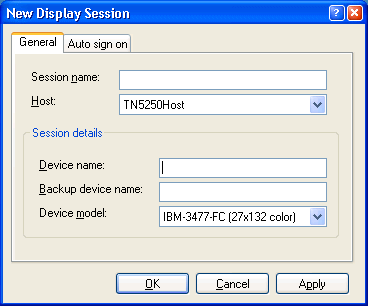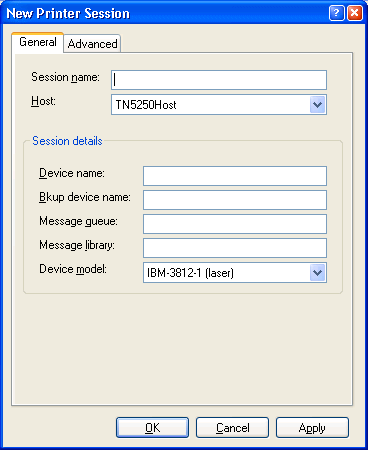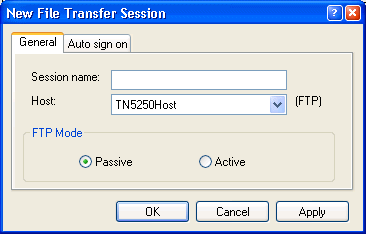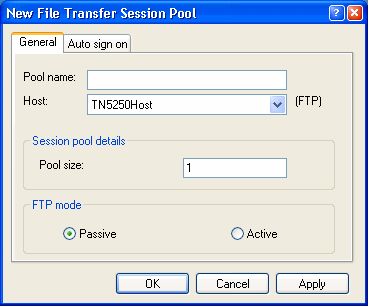5250 service with TN5250 connection to host
Creating a single display session
|
1. |
Right-click on the Single Sessions sub-node and select New Display Session.
The New Display Session dialog box opens:
|
|
2. |
In the Session name field, type a descriptive name for the session. |
|
3. |
In the Host drop-down menu, select your TN5250 host (which must already be created). |
|
4. |
In the Device name field, type the name of the device that you want this session to use. This is an eight character alphanumeric string that
identifies the session on the AS/400. Leave this field empty if you want to use the next available device from the host. |
|
5. |
If available, enter a Backup device name to be used in case the main device is not available. |
|
6. |
In the Device model drop-down menu, select the appropriate device model. |
|
7. |
Click on the Auto sign-on tab to enable and configure the automatic sign-on option to the AS/400 host.
|
a. |
To enable auto sign on, select the Enable auto sign on check box. |
|
b. |
Type the User ID and Password in the corresponding fields. The remaining fields are optional.
|
|
Creating pool of display sessions
|
1. |
Right-click on the Pools sub-node and select New Display Session Pool.
The New Display Session Pool dialog box opens:
|
|
2. |
In the Pool name field, type a descriptive name for the pool. |
|
3. |
In the Host drop-down menu, select your TN5250 host (which must already be created). |
|
4. |
In the Session pool details section, define the following:
|
a. |
Device model — select the appropriate device model. |
|
b. |
Pool size — type the size for this pool. The pool size defines the maximum number of concurrent sessions that can connect to the defined
host using this pool definition. |
|
Creating a single printer session
|
1. |
Right-click on the Single Sessions sub-node and select New Printer Session.
The New Printer Session dialog box opens:
|
|
2. |
In the Session name field, type a descriptive name for the session. |
|
3. |
In the Host drop-down menu, select your TN5250 host (must be already created). |
|
4. |
In the Device name field, type the name of the device to use in the session. This is an eight character alphanumeric string that identifies
the session on the AS/400. Leave this field empty to be allocated the next available device from the host. |
|
5. |
Assign a message queue and a message library to this session in the Message queue and Message library fields. These fields are optional. If you don't assign a value to these fields, they default to QSYSOPR and QSYS respectively.
|
|
6. |
In the Device model drop-down menu, select the appropriate device model. |
|
7. |
Click the Advanced tab to configure Printer options for both APPC and TN connections. 
|
a. |
In the Form feed mode drop-down menu, select how to end a print job when the [emulation] server receives a Form Feed character. |
|
b. |
Select the Font type style ID check box and type a value representing the font size for your print jobs. |
|
c. |
Select the Enable host print transform check box to enable the remainder of the dialog box.
|
1. |
Specify ASCII code support and the Printer model.
|
|
2. |
When checked, ASCII Code specifies that ASCII is used. |
|
3. |
When checked, the Enable workstation customizing object feature enables the following lists:
|
• |
You must specify a printer manufacturer type in the Printer model drop-down menu. The AS/400 will use this model of printer to print host print jobs.
|
|
• |
WCS name names the object containing the definitions of the workstation customization tables for this device.
|
|
• |
WCS library specifies the location of the workstation customizing object.
|
|
|
4. |
Primary paper source specifies the primary paper source on the host printer.
|
|
5. |
Secondary paper source specifies the secondary paper source on the host printer.
|
|
6. |
Envelope source specifies the envelope source on the host printer.
|
|
|
Creating a single file transfer session
|
1. |
Right-click on the Single Sessions sub-node and select New File Transfer Session.
The New File Transfer Session dialog box opens:
|
|
2. |
In the Session name field, type a descriptive name for the session. |
|
3. |
In the Host drop-down menu, select your TN5250 host (must be already created). |
|
4. |
In the FTP mode section, select the type of FTP file transfer you want to use for this session. |
|
5. |
Click the Auto sign on tab to enable and configure the automatic sign-on features for the AS/400 host.
|
a. |
To enable this feature, select the Enable auto sign on check box. |
|
b. |
Type the User ID and Password in the corresponding fields. |
|
Creating a pool of file transfer sessions
|
1. |
Right-click on the Pools sub-node and select New File Transfer Session Pool.
The New File Transfer Session Pool dialog box opens:
|
|
2. |
In the Pool name field, type a descriptive name for the session. |
|
3. |
In the Host drop-down menu, select your TN5250 host (must be already created). |
|
4. |
In the Pool size field, type the number of file transfer sessions for the pool. This will be the maximum number of concurrent users that this
pool can serve. |
|
5. |
In the FTP mode section, select the type of FTP file transfer to use for this session. |
|
6. |
Click the Auto sign on tab to enable and configure the automatic sign-on features for the session.
|
a. |
To enable the feature, select the Enable auto sign on check box. |
|
b. |
Type the User ID and Password in the corresponding fields. |
|





